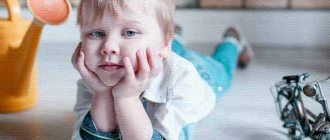Alalia is an insufficiency (deficiency) of speech that is not associated with somatic hearing or intellectual impairments. It occurs against the background of damage to the speech lobes of the brain during childbirth or in the prenatal period.
The most severe degrees of the disease are manifested by a complete lack of speech or incoherent babbling. A mild degree of impairment is characterized by difficulties in mastering writing and reading skills, a limited vocabulary and other deviations in the use of speech structures.
Forms of motor alalia in children
Depending on the location of the brain damage, the following types of motor alalia are distinguished: afferent and efferent.
Afferent (kinesthetic)
This form is caused by damage to the area of the cortex that is responsible for the kinesthetic control of the speech program. It is located in the inferior parietal region of the left hemisphere. At the same time, it is difficult for the child to reproduce words and sentences and find articulatory poses. That is, the baby does not know how to position his tongue, lips, teeth when pronouncing a word.
The condition is called oral-articulatory apraxia. Outwardly, it manifests itself by replacing sounds and distorting the structure of syllables.
Efferent (kinetic)
Efferent motor alalia develops due to damage to Broca's center - the posterior frontal areas of the brain. This zone is responsible for controlling the switching of articulatory acts. Children with this pathology find it difficult to follow the sequence of speech movements. As a result, the syllabic composition of the word is distorted, and speech slows down. In science, this syndrome is called kinetic apraxia.
There are also levels of motor alalia. This classification takes into account the degree of speech underdevelopment. At level 1, the baby is extremely limited, uses a few everyday words, and the basis of speech is onomatopoeia and babble. Level 2 is characterized by a wider range of words and the ability to compose short sentences. Level 3 of motor alalia is distinguished by the presence of phrasal speech.
Classes with a speech therapist
Correction of motor alalia is impossible without sessions with a speech therapist or speech pathologist, since the child needs to develop the organs of the speech apparatus. The course of classes with a speech therapist includes the following exercises and tasks:
- Linguistic gymnastics is aimed at developing the main organ involved in the production of sounds. To do this, the child performs the same exercises many times to strengthen the tongue muscles.
- To develop speech, games are played aimed at developing fine motor skills (this connection has already been discussed above). These include modeling from plasticine, assembling puzzles, appliqués, playing with construction sets, etc.
- Working with pictures is necessary so that the child learns to attach correct visual images to words.
- Speech therapy massage is designed to strengthen the muscles of the tongue, lips and face - that is, all those that are involved in the work when speaking.
Causes of motor alalia in a child
The development of motor alalia occurs due to damage to the motor centers of speech in the brain.
Depending on the time of exposure to the traumatic factor, there are:
- Prenatal factors are those that affect the fetus. This group includes infectious diseases of women during pregnancy (rubella, cytomegalovirus infection, toxoplasmosis are especially dangerous), diabetes mellitus, toxicosis, incompatibility of the fetus and mother according to the Rh factor, hypoxia. Brain damage can also be caused by severe stress, physical trauma of a woman, taking medications that are contraindicated during this period, taking alcohol and drugs, smoking;
- Intranatal factors are those that act during childbirth. These include birth injuries to the brain and asphyxia. These factors lead to the death of neurons. Stimulation of labor, rapid labor, the use of obstetric forceps, premature rupture of water, premature placental abruption, and entanglement of the umbilical cord have a negative impact;
- Early postnatal factors. This group includes traumatic brain injuries, meningitis, encephalitis, and brain tumors that occurred in the first year of a child’s life. Infectious diseases, anemia, rickets, and malnutrition can also have an effect. A special role is played by a lack of communication, attention from parents, and emotional upheavals at an early age (separation from mother, for example).
A characteristic feature: the earlier and longer the negative factor was exposed, the more pronounced the motor alalia, the more serious the consequences and the more complex the prognosis.
Signs of motor alalia in children
Symptoms vary in severity: from minor difficulties that practically do not interfere with normal life, to a complete absence of spoken language. Both the phonetic-phonemic and lexical-grammatical components suffer.
At an early age, the pathology is characterized by poor speech reactions. A 2-year-old child may have no babbling at all. Children actively use gestures, onomatopoeia, and primitive babble to communicate.
A child only develops his first words at the age of 3 or a little later. And at the same time he confuses sounds, replaces them, skips them. Can repeat syllables or individual sounds, connect inappropriate syllables from different words.
A 4-year-old child has a poor vocabulary, the phrases are incomprehensible and incorrectly composed. And in the future, he mainly uses nouns, ignores conjunctions, prepositions, and very rarely uses adjectives, verbs, adverbs, and function words. Words do not agree in cases, numbers, genders and tenses. He divides words when speaking and speaks slowly.
A baby cannot repeat sounds after an adult, not to mention phrases. He cannot relate the word and the situation, so he uses words incorrectly.
At the same time, the child understands the addressed speech: he can fulfill the request or respond with a gesture.
Symptoms of psychological and neurological disorders are also observed. Such children, as a rule, are not very active. They are calm about their condition. In general, they are clumsy and have poor coordination and fine motor skills. For example, it is difficult for them to thread a needle, pick up a small object and transfer it.
Attention, memory, and thinking suffer. Children have an unstable emotional background, they are whiny, which makes communication with others even more difficult. There may be sleep and appetite disturbances.
Diagnosis of motor alalia in children
The examination is carried out with the participation of several specialists. The medical part of pathology is dealt with by a neurologist, otolaryngologist, and pediatrician. Consultation with a speech therapist and psychologist is required. At this stage, specialists are faced with the task of making an accurate diagnosis, identifying the degree of impairment, and excluding other speech disorders.
Diagnostics include:
- Medical examination - history taking, examination of a small patient. Any details are important: how the mother’s pregnancy and childbirth proceeded, how the newborn period progressed, features of physical and neuropsychic development. A neurologist identifies problems with motor skills, poor coordination of movements, uneven reflexes, decreased or increased muscle tone. Electroencephalography, Doppler examination of cerebral vessels, and MRI help determine the diagnosis and cause of the disorders;
- A speech therapy examination consists of assessing speech and its levels of development. The specialist uses tests to determine the volume of vocabulary, level of speech development, grammar, syllable structure and other indicators. The movements of the lips and tongue, the accuracy of these movements, and articulatory switches are assessed;
- Psychological examination - assessment of the emotional-volitional sphere and cognitive abilities by a psychologist. For motor alalia in preschoolers, testing is carried out in the form of games so that the child can fully open up and the specialist can actively monitor the patient’s behavior, simulating various situations.
Having received complete information about the patient, specialists determine treatment tactics and prognosis.
List of sources
- Zinchenko S.N., Chursina L.V., Buzyan T.V., Mikitenko E.V. Undesirable effects in the development of children with speech disorders // Modern Pediatrics. – 2014. – No. 5. – P. 44.
- Child psychoneurology / ed. Bulakhova L.A. – K.: Health, 2001. – 486 p.
- Chutko L.S., Livinskaya A.M. Specific disorders of speech development in children: educational and methodological manual. - St. Petersburg, 2006. - 48 p.
- Belousova M.V., Prusakov V.F., Utkuzova M.A., Gamirova R.G. Perinatal factors in the genesis of speech disorders in children // Practical Medicine. - No. 1 (66). — P. 117-121.
- Child psychoneurology / ed. Bulakhova L.A. – K.: Health, 2001. – 486 p.
Treatment of motor alalia in children
The therapy is complex, aimed at eliminating the cause of the disease, correcting disorders, influencing the sensory, intellectual, emotional and volitional sphere. A psychologist/neuropsychologist, a neurologist, and a speech therapist/speech pathologist work with the patient.
It is advisable that treatment of motor alalia, regardless of the symptoms, be started as early as possible. The optimal period is 3–4 years. Preschoolers are easy to correct; moreover, no violations were recorded at this age. Another important condition is the regularity of the exercises.
The medical part of the correction consists of drug therapy, physiotherapy, and massage. These procedures eliminate brain disorders, restore blood flow in blood vessels, and improve motor function.
Psychological treatment for signs of motor alalia in children is aimed at improving memory, attention, thinking, and control of the emotional-volitional sphere.
Physiotherapy
Physiotherapeutic methods are aimed at strengthening the body and stimulating the nervous system. These include water treatment (mechanical, temperature or other effects on the body), ultrasound treatment, magnetic field, weak electrical impulses, etc. In any case, regardless of the methods used, the correction must be comprehensive and systematic. Only a neurologist can prescribe these procedures. Since speech is an important and frequently used skill, parents should perform speech therapy exercises at home on their own as directed by a specialist.
Corrective work
Speech therapy correction includes several areas and stages:
- Stimulation of speech activity. At the initial stage, it is important to create motivation, activate speech reactions, teach to imitate someone else’s speech, and enrich the vocabulary. The baby also learns to conduct a dialogue. It is easier to achieve results if you use a game form of training;
- Stimulation of phrasal speech. This stage begins after the baby has formed a certain set of words and develops the skill of conducting a dialogue. Then it becomes possible to construct simple sentences that gradually become more complex. At the same time, children learn the correct construction of words and sentences, grammatical errors disappear from their oral speech;
- The development of coherent speech involves teaching a child how to conduct a monologue or story. He learns to formulate a thought, retell what he read or heard, compose a story based on a picture, and compose. Grammar is reinforced;
- Elimination of phonetic-phonemic disorders through various exercises. The baby learns to pronounce sounds correctly, focusing on the position of the organs of articulation during classes and in everyday life. Over time, such control becomes automatic.
We would like to note the role of parents in the development of speech in a child. It is important to encourage his successes and his speech activity in every possible way. But if something doesn’t work out yet, you shouldn’t scold him.
Possible complications and consequences
Due to the fact that expressive speech is impaired, a child with motor alalia does not communicate well with others and peers. Thinking, memory, perception, imagination suffer. All this undoubtedly leaves its mark on development. Alalik is afraid to contact strangers, this is especially pronounced in a new environment. Even with children of the same age, he cannot find a common language and build communication.
Preschoolers in kindergarten stay apart. At school they have difficulties with writing, reading, and mastering grammar. In some cases, the disease is complicated by stuttering, which further complicates the prognosis.
Parents should understand how to treat motor alalia in a child and that this disease is not a developmental disorder and is not a temporary phenomenon. This is a disorder of speech formation, which is accompanied by a pathological process in the central nervous system. Often mothers and fathers make the mistake of believing that their baby is developing normally, and speech impairment is a variant of the norm at that age. As a result, the disease is diagnosed in late stages and the possibility of a complete cure is in question.
Forecast
In most cases, with timely treatment, children recover. Over time, their speech becomes understandable, and in terms of intellectual development, such a child will not lag behind his peers. But in some cases, due to the advanced form of alalia, doctors cannot guarantee complete relief from this disease.
Sign up for a consultation. The children's speech therapist and psychologist of the center will determine the individual causes of alalia, give recommendations for correction, and also draw up a plan for classes in the center and at home. This system of work will make the correctional route the most effective and will successfully harmonize the baby’s development process.
Prognosis and prevention
The result depends on the type of motor alalia, the severity, and the age at which the disease was diagnosed and therapy was started. If all these conditions are met and adequate treatment is provided, the prognosis is favorable. Children catch up with their peers in speech and general development, acquire communication skills and even study in a regular school.
Severe motor alalia is difficult to correct, especially if it is diagnosed late. But with due persistence and following the doctor’s recommendations regarding treatment, it is possible to achieve significant progress.
Prevention of motor alalia begins during pregnancy planning. The expectant mother needs to eliminate bad habits, adjust her diet and daily routine. It is necessary to approach childbirth adequately and prevent injuries. It is also important to create favorable conditions for the development of the child in the postpartum period and subsequently, to devote time to developmental activities.
And of course, it is necessary to consult a doctor at the first signs of deviations in speech development in order to undergo a timely diagnosis and identify the cause.






